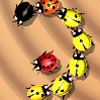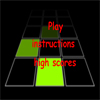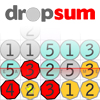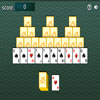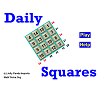
Description
Daily Squares is a daily puzzle game. The object is to arrange all of the active blocks such that all of the rows, columns, and diagonals all add up to 34.
The games is based on the basic concept of magic squares. In this case, it is a 4×4 magic square. If you are familiar with the game Sudoku, then you may find it interesting that Sudoku is based on magic squares.
Come back and play often – there is a new game every day!
Instructions

Description
Help RoboClock make time fly. Or at least let him figure out which clock he needs to fly to and capture. Helps practice your time telling skills
Instructions
Help RoboClock get through all five levels of this telling time game by selecting the right time.

Description
An online maths game with an almost infinite supply of math division problems to solve.
Instructions
Choose from 3 levels of division sums ranging from single digits to three figure problems. Each sum is randomly produced one at a time on a blackboard style interface. Audio and visual encouragement tells you when you are right and when you need to try again.
The Questions
Once you have clicked on your choice, a random question will appear which you have to solve by clicking on the numbers in green in the white boxes at the bottom of the blackboard. You will be told visually and audibly whether you have got the answer correct or not. When you are able to try the next sum, the Next Sum button will become active at the bottom of the board. At anytime you can try a new level by clicking on the New Level button at the bottom but be aware that your score will drop to zero and any stars earned will be lost. The question number, scores and stars will be kept only if you move to the certificate screen and back to the same level.
Level 1
In Level 1 the answers to all the problems are whole numbers. The number in the white divide box is called the dividend and is the figure to be divided. The number to the left just outside the box is called the divisor. Basically you have to find out how many of the divisor number is in the dividend. For example if the dividend is 20 and the divisor is 5, the problem is to find out how many 5’s there are in 20. The best way to think of this is a cake cut into pieces. In this problem the cake has been cut into 20 pieces. You have 5 greedy boys to feed with the cake but so that each one gets the same you need to know how many slices each one can have. Remove 5 slices and put them on an imaginary plate. Remove another 5 and put them on another plate, and then another etc. You should find that you end up with 4 plates each with 5 slices of cake on them. This means that there are 4 lots of 5 in 20.
Level 2
Not all answers to division problems are exact. In Level 2 the answers to the problems are a mixture of whole numbers and ones with what is called a remainder. Using the cake example above, you have a cake which has been pre cut in the shop into 20 slices. This time you have 6 hungry boys to feed. Remove 6 slices and put them on an imaginary plate. Remove another 6 and put them on another plate, and then another etc. You should find that you can only fill 3 plates with 6 slices of cake on them and there will be 2 slices of cake left. This means that there are 3 lots of 6 in 20 with a remainder of 2. If this was the question in my program then firstly you would click the number 3 as being the first part of your answer. Then click the Remainder button to add a letter R after your answer. Then click the number 2 being the amount remaining. So your answer to 20 divided by 6 is 3 remainder 2 i.e. 3×6=18, 20-18=2.
Level 3
In Level 3 the dividend numbers get a little bigger and some may have two lots of remainders. For example 100 divided by 6. If this problem was on the screen you would see that as well as a green box around the divisor 6 there is another green box around part of the dividend. In this case the box encloses the number 10. The green boxes should be worked out first, so how many 6’s are there in 10? Well there is only 1, 6 in 10, so your first answer to click will be 1. But 10 is bigger than 6 so there is a remainder. 10-6=4 so click the Remainder button and the number 4. The number 4 should appear not at the end of the sum but just before the last 0 and a green box should appear around these two numbers. With 4 next to the 0 this number is now just as you would read it. It is no longer 0, it is now 40. So the problem is now how many 6’s are in the number 40. The answer is that there are 6, 6’s in 40 with 4 left over as a remainder. 6×6=36, 40-36=4. So the next number to click is 6 followed by the remainder button again and then click the number 4 being what is left over after the sum has been solved.
Remainders help you to understand how division works but in today’s World we work in decimals. In the last problem you could continue to work the problem out by placing a decimal point after your top answer i.e. 16. The remainder 4 would then go against an imaginary 0 to make 40 again. You then keep on dividing by 6. In this problem your answer would be never ending i.e. 16.6666666666666666666666 etc. which is why it is not practical for this program to show the decimal answer to the problems. If you did this problem on a calculator it would also probably give up and produce an answer of say 16.6666667. This is because many calculators are restricted to a set number of digits, so it rounds the last digit up one if the next number in the sequence is above 5. In more advanced mathematics the correct way to express this answer is to say 16.6 recurring i.e. the 6 goes on and on indefinitely.
Tables
To help with you there is a Tables chart at the top of the screen. It’s the yellow tab with CLICK TO LOWER TABLES on it. Click this and the chart showing the Times Tables from 1 to 9 will be shown. Click the chart again to raise it back to the top of the blackboard. Clicking this chart does not alter your score but does affect how many stars you are awarded (see below).
The Tables chart has the numbers 1-9 along the top and also down the left hand side. In Division take the first number to the left of the white divide box, this is called the divisor. Find this number’s row down the left hand side of the Tables. Follow this row along until you find a number which is the same or just above the second number in the question enclosed in the divide box. This second number is called the dividend. The number at the top of this column in the darker yellow is the answer if the number in the main Table is the same as the dividend. If the number in the Table is just below the dividend then the number at the top is still the first part of your answer but there is also a remainder. The remainder is the number left over after you subtract (take away) the dividend from the number in the main Table. For example 5)30 where 30 is the dividend (the number to be divided) and 5 is the divisor. Find 5 in the left hand column of the Tables and move along that row until you reach 30. Look up to the top of the column in which 30 appears and you will see the number 6, which is the answer to the problem i.e. there are 6, 5’s in 30. If instead the dividend was say 31, then 6 would still be the answer but there would also be a remainder. The remainder in this problem is 1 as the dividend 31, take away the answer to 5×6 which is 30, =1 (31-30=1).
Bonus Stars
One gold star is awarded in a level, each time you get 10 answers correct without using the Tables described above. Any stars earned in a level will be shown on your certificate. Please note any stars earned in one level, are lost if you try another level.







